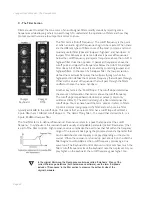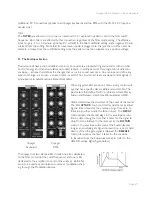
Page 14
Voyager User’s Manual - The Basics
Page 15
Voyager User’s Manual - The Basics
Control Voltage Path
When a key is pressed, or a MIDI Note On message is received, a Gate and Pitch Control Voltage (CV) are
produced. The Gate signal is used to trigger both the Filter and Volume Envelope Generators (EGs). The
Pitch CV is used to determine the pitch of the Oscillators and can be applied to a varying degree to the
Filters through the Keyboard Control Amount knob. The basic control voltage path is illustrated below.
Modulation Path
Modulation is performed through the Modulation Busses. There are two separate Mod busses. One is
controlled by the Mod Wheel, while the other is controlled by the MOD1 CV, which is a CV input on the
back panel. The MOD 1 CV input is normalled to +5V, so with nothing plugged into this jack, the PEDAL/
ON bus is on at the level determined by the PEDAL/ON Amount control. In each Mod Bus, a Modulation
Source, Shaping signal and Destination are selected. An overall maximum modulation amount can be set
with the Amount control. The Modulation Buss routing is illustrated in the figure on the next page.
The Voyager’s Low Frequency Oscillator (LFO) is assigned through the Modulation Busses. The LFO features
a triangle and a square wave, and both waves can be used at the same time. The LFO is also used to trigger
the Sample and Hold circuit, which means the speed of the Sample and Hold is adjusted by the LFO
RATE
control.
The Voyager’s Control Voltage Path







































